| |
Cryptocoryne nurii Furtado var. nurii |
| (Document service) |
< Sorry, this page from 2001 will be reworked soon !>
back to the nurii-group
Click on the picture to get the full image (ca. 50 kB) |
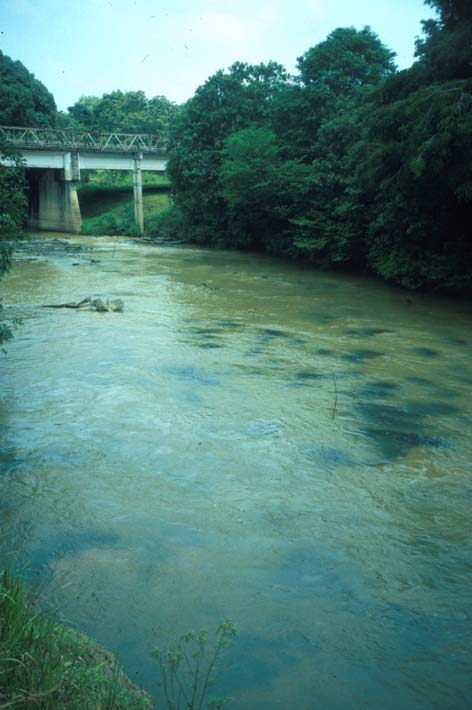 |
View on the Kahang river in Johore. The dark patches in the
water are pure stands of C. nurii
coll. B802 |
|
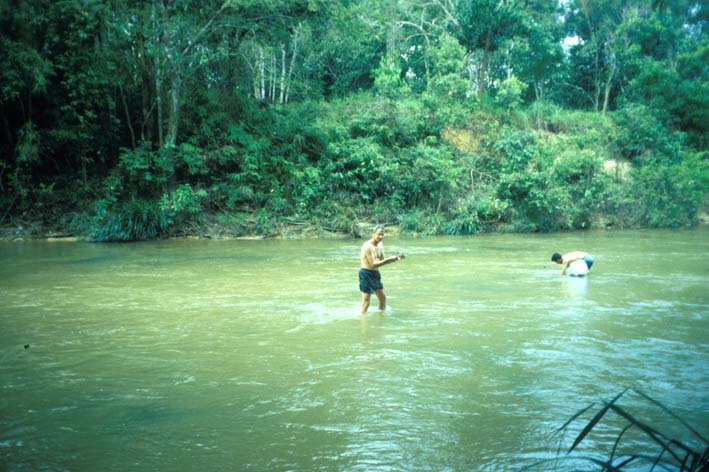 |
It is easy to walk in the river bed during the dry season
(end of May) and collect some plants.
coll. B802
|
|
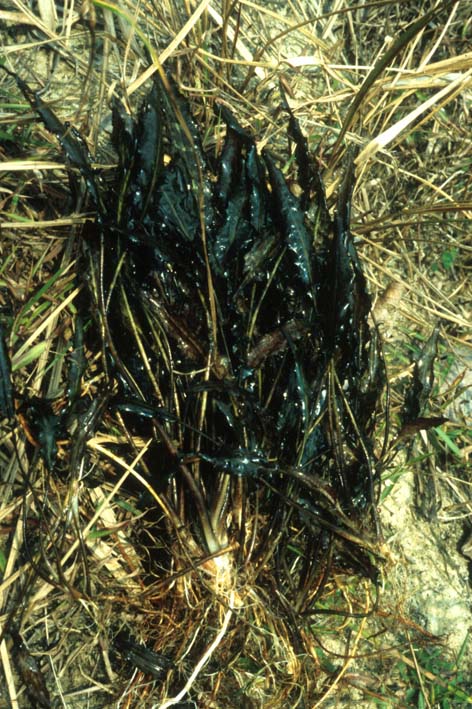 |
The c ollected plants are almost black, 25 cm (10") long
and have narrow ovate leaves with an undulated margin. No inflorescences were found.
coll. B802 |
|
 |
In emersed cultivation, this plant is much smaller and also
the spathe has a short tube. See for details of the limb below.
coll. B802, cult. Eichner
photo Eichner
|
|
| |
|
|
|
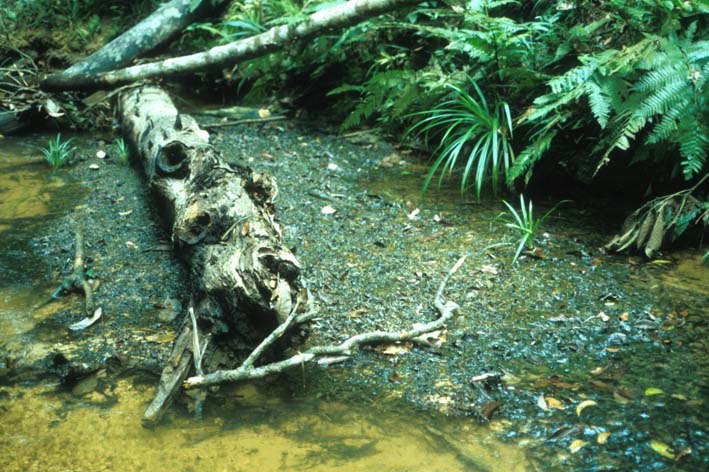 |
A small jungle stream in Johore with very slow running water.
Thousands of C. nurii (and lot of leeches).
coll. B803
|
|
 |
The leaves are brownish and wider compared to these from the
Kahang river.
coll. B803
|
|
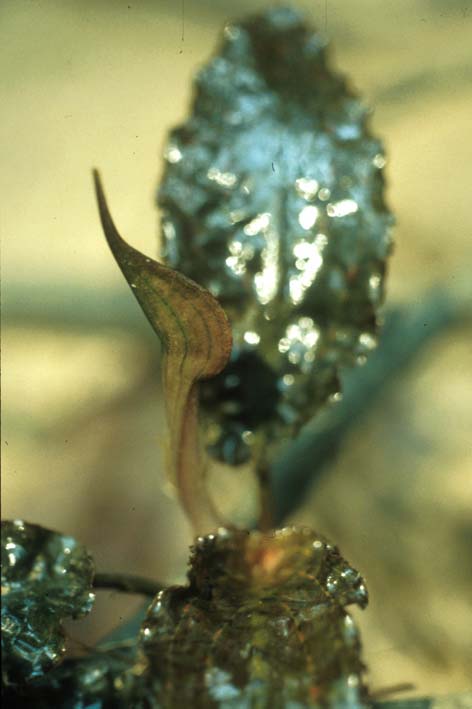 |
Before the limb opens, the spathe shows the typical formed
bud.
coll. B803
|
|
 |
Only a few C. nurii were flowering in the stream.
Note the rough surface of the limb.The width of the limb is c. 2.5 cm (1").
coll. B803
|
|
| |
|
|
|
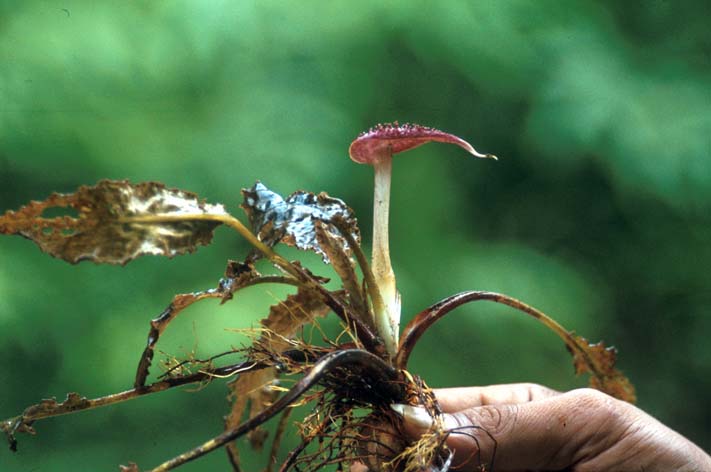 |
Jacobsen collected C. nurii near Mersing in the
state of Johore. This is a very typical picture of the spathe of C. nurii.
coll. NJ78-59
photo Jacobsen
|
|
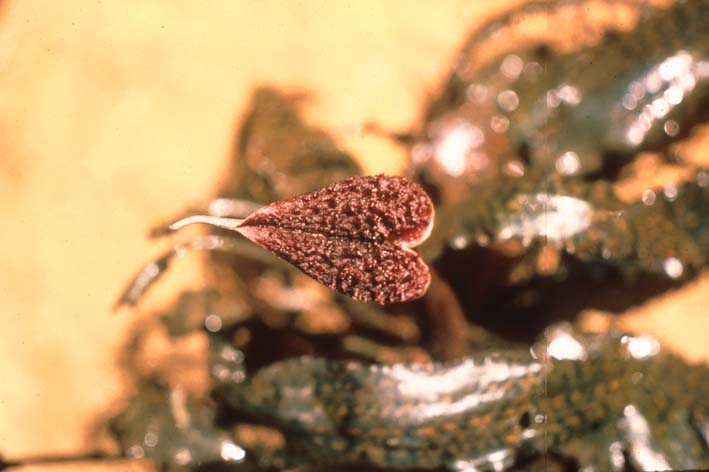 |
This C. nurii is collected by Jacobsen in the south
of the Pahang state. The plants were up to 40 cm (16") long.
coll. NJ85-33
photo Jacobsen
|
|
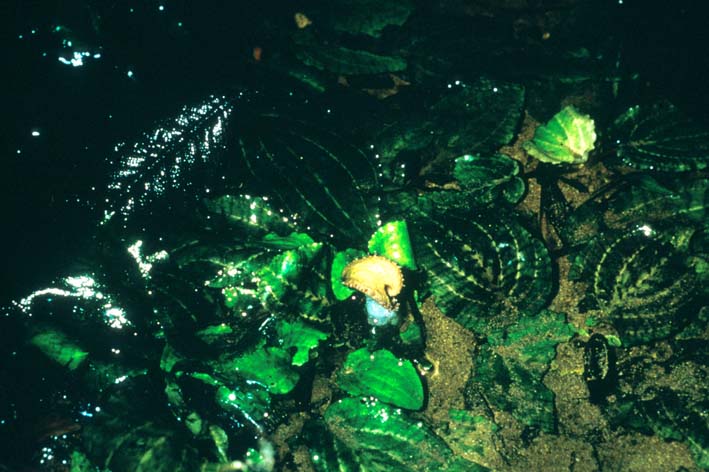 |
This plant with a yellow limb of the spathe and the pallid
nerves on the leaf, is found by Peter Boyce in the Taman Negara F.R.(Pahang).
photo Boyce
|
|
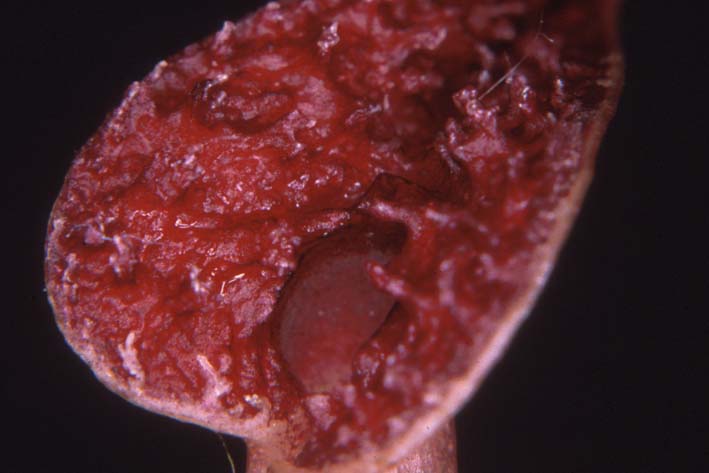 |
Close up of the limb of the plant from the Kahang river
(Johore). Note the irregular outgrows (protuberances)
coll. B802, cult. Eichner
photo Eichner
|
|
| |
|
|
|
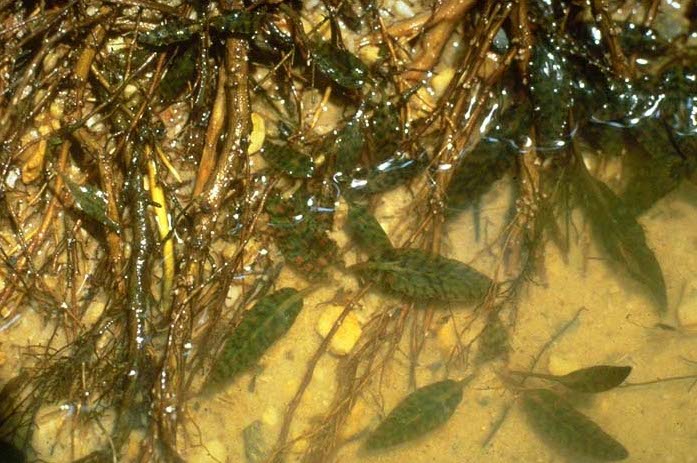 |
A wide stream near Mersing (Johore) with C.
nurii growing submersed. The leaves often have pallid veins and transverse markings.
Sometimes they show some red dots.
coll. FW
photo Waser
|
|
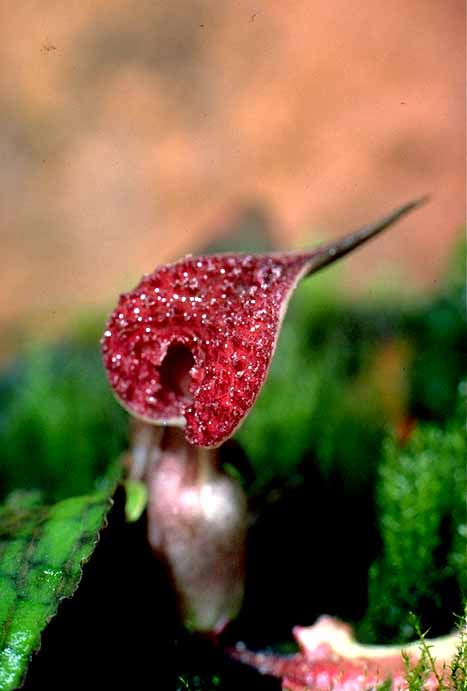 |
A emersed cultivated C. nurii. The
plant is very tiny, as is the spathe. Compared to C. minima, the limb has a
pronounced cordate base, stands more or less horizontal and has a small tail.
coll. hort., cult. B9
|
|
 |
In emersed culture, the leaves may show a
different colored venation. This plant was very weak and did not survive for a long time.
The ruler displays cm.
coll. hort., cult. B9
|
|
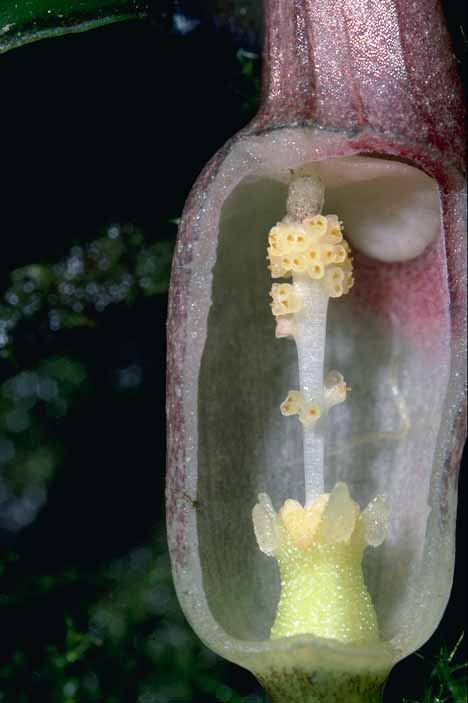 |
Opened kettle of C. nurii. It is a bit
abnormal in showing some male flowers halfway the spadix. This is occasionally seen in
many species. The number of the male flowers is rather low.
coll. hort., cult. B9
|
|
| |
|
|
|
 |
Van Wijngaarden discovered a somewhat deviating
form of C. nurii in an import shipment. Note typical bud of the inflorescence.
coll. hort., cult. W95
photo van Wijngaarden
|
|
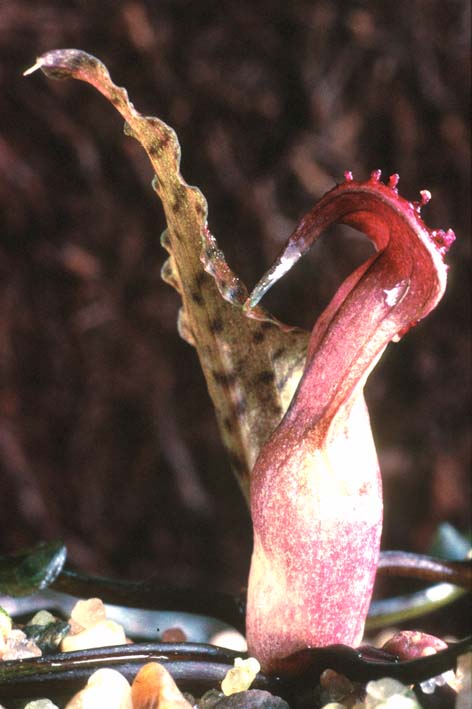 |
The leaves are brownish marmorated. The limb of
the spathe shows the typical structure with the irregular protuberances.
coll. hort., cult. W31
photo van Wijngaarden
|
|
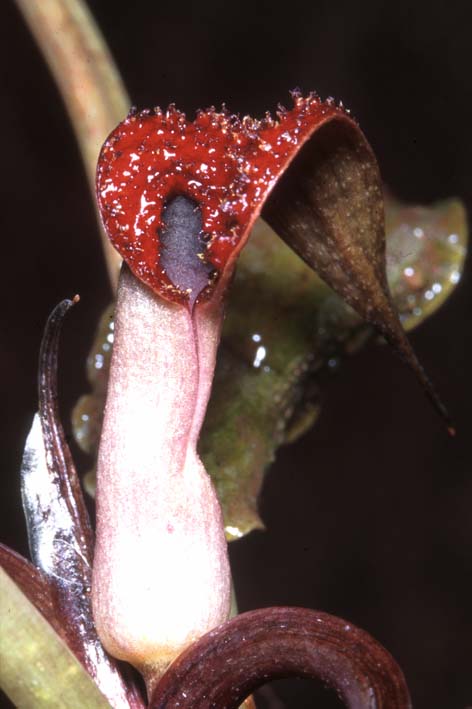 |
The same plant seen from the front. Although the
limb of the spathe is less cordate, it must be regarded as C. nurii.
coll. hort., cult. W83
photo van Wijngaarden
|
|
 |
In the same shipment were other plants found
which showed a yellow limb of the spathe
coll. hort., cult. W95
photo van Wijngaarden
|
|
| |
|
|
|
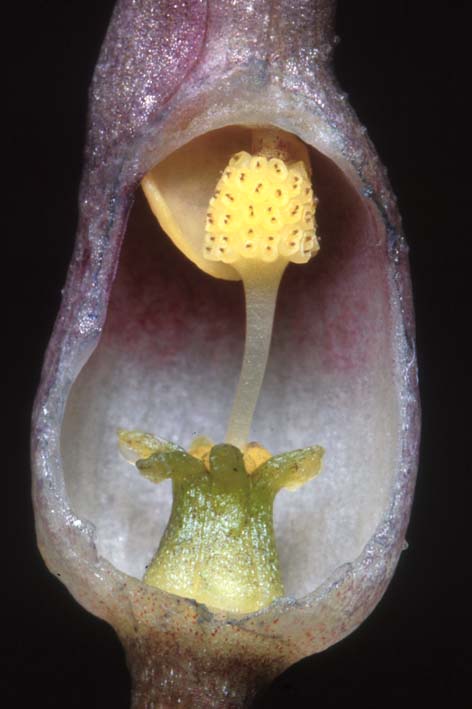 |
A normal developed kettle of C. nurii.
Note the reddish hue on the upper side of the kettle.
coll. hort., cult. W93
photo van Wijngaarden
|
|
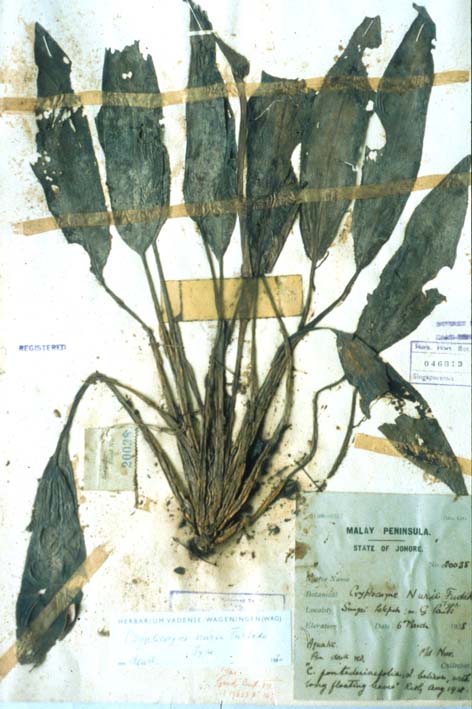 |
Type of C. nurii collected by Nur in
1928. Note the very long tube of the spathe
coll. Nur20038
herbarium Singapore
|
|
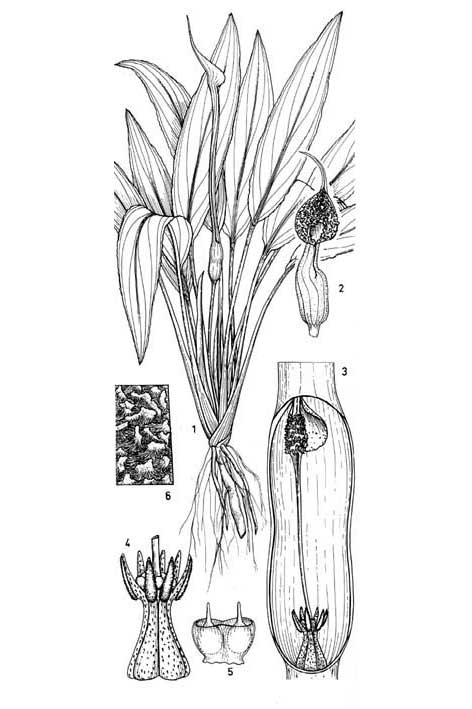 |
Drawing of C. nurii in de Wit (1990).
The opened kettle is probably of a submersed grown spathe (rather long). Note the surface
of the limb.
drawing Ike Zewald
|
|
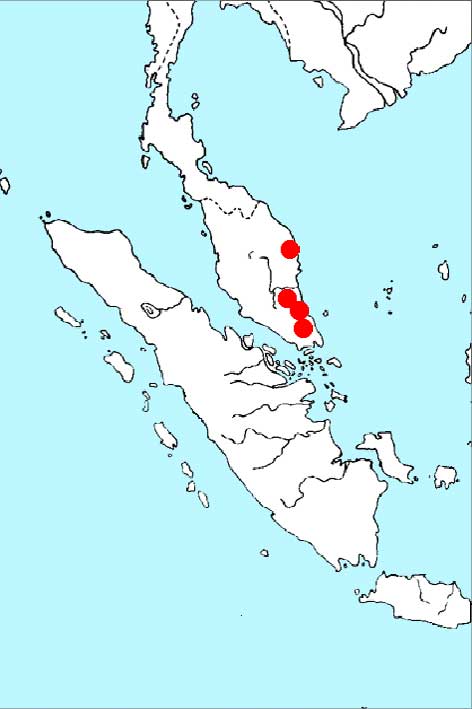 |
Distribution of C. nurii in West
Malaysia. In the south are the 'classical' localities in the state Johore. The other are
found in the state of Pahang.
|
|
| |
|
|
|
Cryptocoryne nurii grows in West Malaysia in Johore and in Pahang on several
places. It is often collected and is exported in thousands. However, this plant is
extremely difficult to cultivate over a long time.
Furtado (1935) describes a plant with leaves up to 35 cm and a spathe with a tube up to 12
cm. As special feature he mentions a peduncle of the spathe of about 10 cm. Apparently he
described a submersed grown plant. In emersed culture, all parts are much smaller, the
spathe not exceeding 5 cm.
Imported non flowering plants of C. nurii can sometimes be recognized by some red
spots, mainly on the main nerve of the blade. Rataj & Horemann (1977) give a nice
picture of this mark. But this feature is not always present. C. nurii shows some
variation both in the spathe and in the leaves. More collections are wanted, especially
from the central and northern parts of W. Malaysia. The C. sp. ('serrulated leaves') is probably also a form of to C. nurii.
Updated January 2001
back to the nurii-group |
Literature.
- Arends, J.C., Bastmeijer, J.D. & Jacobsen, N., 1982, Chromosome
numbers and taxonomy in Cryptocoryne (Araceae).II., Nord.J.Bot. 2 : 453-463.
- Furtado, C.X., 1935, Araceae Malesicae, Gardens Bull.of the Straits Settlem. 8 : 145-148.
- Jacobsen, N., 1982, Cryptocorynen, Alfred Kernen Verlag, Stuttgart.
- Jacobsen, N. & J.Bogner, 1987, Die Cryptocorynen der Malaiischen Halbinsel (2.Teil),
Aqua-Planta 1-87 : 13-20.
- Kasselmann, C., 1995, Aquarienpflanzen, Ulmer, Stuttgart.
- Rataj, K. & Horeman, T.J., 1977, Aquarium Plants, TFH Publ, USA.
- Roe, C.D., 1967, A manual of aquarium plants, Shirley aquatics Ltd.
- Sadilek, V., 1968, Neue Cryptocorynen III : Cryptocoryne nurii Furtado, DATZ 21: 18-20.
- Sadilek, V., 1981, Sind die malayischen Cryptocorynen Problempflanzen ?, Aqua-Planta 3-81
: 76-78.
- Schulze, J., 1967, Beobachtungen über Wasserpflanzen in einigen südostasiatischen
Ländern I-IV, DATZ 20 : 211-215, 248-252, 279-282, 312-314.
- Wit, H.C.D. de, 1990, Aquarienpflanzen, 2. Auflage, Ulmer, Stuttgart.
|
|
|
|
 |
|
|